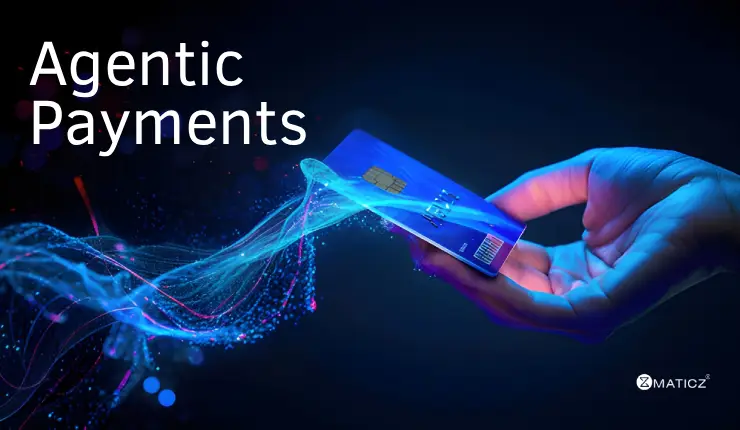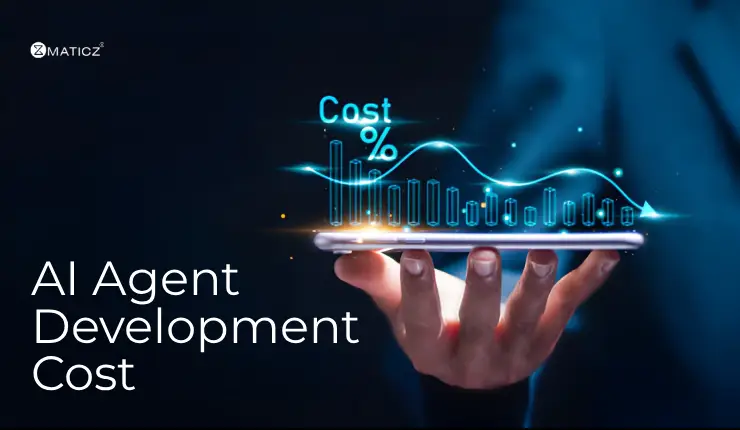Share Posts

Agentic Payments: Transforming the Future of FinTech with AI
46
857
103
Have you ever found yourself saying, “If only this payment could happen automatically while I sleep, so I wake up with it sorted”? Imagine your business invoices being approved, your subscriptions renewed, vendor payments settled, all without someone manually clicking “approve” every time. That’s exactly what this blog is here to unpack.
If you’re running a business—whether you’re a startup founder, finance lead, operations manager, or simply curious about what’s next in payments, you need to understand this shift. We’re talking about agentic payments, how they’re powered by AI, how the future of payments is evolving, and how your business can prepare for and benefit from this change.
In what follows, we’ll step into the world of AI-driven payments, talk about how they differ from what we’re used to today, explore the role of blockchain in payments, dig into protocols like the AP2 protocol, and bring everything back to what you as a business can actually do about it.
What Are Agentic Payments?
When you think about a payment today, you probably imagine a customer clicking “pay”, entering details, maybe being redirected, maybe waiting for confirmation. Now imagine instead that an AI-powered “assistant” or “agent” takes your instructions and completes the purchase or payment on your behalf, within defined boundaries, without you manually triggering every step. That’s the essence of agentic payments.
Specifically:
- An agent (software, AI-driven) is authorised to act on behalf of a user or business.
- It evaluates conditions (budget, policy, risk), then initiates and executes the payment.
- The human still sets the boundaries—what the agent can spend, when, how—but the day-to-day work is delegated.
- For businesses, it means workflows like “invoice arrives → agent checks it → if within policy, agent pays it” instead of manual review at every step.
To put it in simple terms, Agentic payments refer to transactions that are initiated and completed by autonomous agents acting on behalf of humans, with delegated authority. This can be really helpful for businesses, especially with many routine payments like subscriptions, vendor invoices, cross-border transfers, and micropayments.
How Do Agentic Payments Work?
Every agentic payment follows a smart, layered process. Think of it as a mini workflow your AI agent executes each time it’s triggered.
1. Agent Initialization
This is where the AI agent is “born”, configured with permissions, boundaries, and decision-making rules.
For example, your business might authorize an agent to:
- Pay suppliers under a certain limit automatically.
- Approve recurring subscriptions under a monthly cap.
- Execute payments only to verified vendors.
Initialization is about defining what the agent can and cannot do. It’s like setting up a new finance assistant with clear responsibilities.
2. Context Gathering and Monitoring
Once active, the agent continuously monitors relevant data streams like invoices, purchase orders, cash flow, or even conversational triggers.
It watches for:
- When an invoice matches an approved PO.
- When stock levels drop and a reorder is due.
- When a customer confirms a purchase in chat or via voice command.
This “situational awareness” allows the AI to know when an action should occur, not just how to perform it.
3. AI Decision
The AI evaluates the context: Is this payment within the rules? Are funds available? Is this vendor trusted? Is the timing right?
Based on its policy and your inputs, it decides whether to:
- Proceed with payment automatically.
- Flag it for human review.
- Delay or cancel if something looks off.
4. Payment Execution
After the choice has been made, the agent securely starts the payment using the stored credentials through the payment rails you have selected, which can be card networks, banking APIs, crypto wallets, or even blockchain smart contracts.
At this point, AI payments are integrated directly into your systems, and the funds flow effortlessly between the accounts, vendors, or customers.
5. Logging, Auditing, and Compliance
Every action is logged, like when the agent made a decision, what data it used, and how it executed.
This isn’t just for transparency. This is very important for audit, compliance, and trust. In case regulators or finance teams want to check the transactions, the trail is very clear, marked with time, and cannot be altered, especially when using blockchain for payments.
This final stage provides responsibility without increasing the difficulty, closing the loop between automation and governance.
Traditional Payment Automation vs. Agentic Payments
| Aspect | Traditional Payment Automation | Agentic Payments |
| Trigger | Pre-set schedules or rules (E.g., “Pay vendor X every 1st of the month”) | Dynamic AI-triggered actions based on real-time context and conditions |
| Decision-Making | Rigid, rule-based | Adaptive reasoning - agents decide if, when, and how to pay |
| Human Intervention | Required for most exceptions | Optional - Agents can escalate only when rules are exceeded |
| Flexibility | Hard to modify once set | Continuously learns from data and feedback |
| Scalability | Limited by pre-defined workflows | Expands naturally with new data and use cases |
| Auditability | Manual reconciliation required | Automated, logged, and often blockchain-anchored |
Think of it this way. Traditional automation is like an alarm clock. It rings at a fixed time, regardless of what’s happening. Agentic payments are like a smart assistant that decides when to wake you up based on your schedule, meetings, and sleep cycle.
Why Do Agentic Payments Matter For Businesses?
Okay, so you know what agentic payments are. But why should you, as a business, care now?
We’re hearing talk of AI agents becoming standard parts of commerce ecosystems. For example, one recent piece describes agentic payments as “the future of commerce will be increasingly handled by autonomous software agents, not just users.” (Merchant Advice)
Cost and speed matter
Manual payment processes cost money: staff time, errors, follow-ups, and reconciliation delays. If you can offload some of that to an intelligent agent, you free up resources and reduce risk. Also, in a world of tighter margins, faster settlement, and better cash flow matter more than ever.
Reduced Friction
If you’re in commerce, every extra step is a drop-off risk. Agentic payments can embed the payment journey into a conversational or AI-agent-driven experience, reducing checkout friction.
Competitive positioning
If your systems are still built around legacy flows, manual invoice processing, lengthy approvals, and static payment rails, you might find yourself slower compared to a competitor who has designed for the agentic era. In short, it’s not just “nice to have” anymore. It’s starting to be a differentiator.
24/7, everywhere, smart decisions
Agents don’t sleep. They monitor, analyse, and decide in real time. So payments happen when the conditions are right (within rules you set). For businesses working across time zones, managing global supply chains, or with IoT/machine-to-machine payment scenarios, this matters.
Smarter cash-flow and treasury management
Agentic payments don’t just automate execution, they allow for intelligent decision-making: when best to pay, how best to route funds, which supplier to prioritise, even when to hold off for better terms.
Who Has Already Implemented Agentic Payments? Biggest Releases By Global Leaders
The world’s biggest financial players have already jumped in, and their success stories are paving the way for everyone else. Each of these moves isn’t just innovation for the sake of buzz. It’s a collective signal that the payment world is shifting from “manual and reactive” to “intelligent and proactive.”
1. Stripe: Embedding AI Agents into Payment APIs
Stripe has been integrating AI assistants that can interpret context (like invoice metadata or chatbot requests) and initiate payments automatically. Its developer-first ecosystem makes it ideal for embedding agentic logic directly into business workflows, especially in e-commerce and SaaS.
2. Visa: Agentic Payment Authorization
Visa’s experiments with autonomous payment authorization systems allow AI agents to act within customer-defined rules. For instance, approving travel-related expenses up to a set limit. It’s combining its global payment rails with AI intelligence to redefine smart spending.
3. Mastercard: “Agent Pay” Technology
Mastercard took a bold step by launching Agent Pay, its first large-scale AI payments platform that enables agentic transactions. The goal? Let verified AI agents make payments across merchants and devices, powered by tokenization and secure identity. This is seen as a foundational shift for agentic commerce.
4. PayPal: Conversational Checkout
PayPal has rolled out conversational payment experiences where AI bots can handle payments inside chat windows or voice interactions. Think “Hey PayPal, send $100 to my designer” and it’s done securely, instantly.
5. Coinbase: Blockchain-based Agentic Payments
In the crypto industry, Coinbase is using smart contracts and artificial intelligence (AI) to wholly automate crypto payments. The very use of blockchain in financial transactions allows the agents to operate in an environment that is completely transparent and verifiable, which is exactly the case for decentralized, cross-border transactions that require auditing.
Agentic Payments in Action: Practical Applications for Every Industry
Let us consider certain specific instances in order for you to understand better how this is going to be applied in businesses.
E-commerce and Conversational Commerce
Imagine a customer chats with your brand’s AI-assistant: “Hey, I’d like a new laptop, under $800, shipped to Chennai by next week.” The agent recommends a few models, the customer picks one, and the same agent triggers payment and shipping, all within the chat. The user never leaves the chat app or fills multiple forms. That’s agentic payments at work.
According to reports, Indian fintechs have already rolled out agentic payments in chat to reduce checkout drop-off. For your business, this means smoother customer journeys, lower abandonment, and potentially higher conversion.
B2B Automation
Your business may receive many invoices from suppliers. With agentic payments, you can assign an “agent” to verify the invoice against the purchase order, check if goods/services were delivered, evaluate vendor rating, and then execute payment if all checks pass.
That reduces manual burden, speeds up supplier payments, and frees up treasury staff for exceptions and strategy. Research shows agentic AI can sift through delivery data, market signals, and trigger payments.
Internet of Things (IoT) Billing or Machine-to-Machine Payments
If you work in connected devices (e.g., smart appliances, vehicles, sensors), there will be scenarios where one device pays another device for a service like a repair, a recharge, a service call. Agentic payments make that possible: the “agent” embedded in device A determines when to request service, approves payment, and executes it without human involvement. It’s futuristic but increasingly viable.
Subscription Models, Usage-based Billing
In case your company provides subscriptions (software, service, hardware), the agents would be able to keep track of usage or service limits and consequently renew the subscription or accept the additional payment when the specific triggers are reached. That means you don’t rely only on renewal emails or invoices; the system handles it more proactively and accurately. Agentic payments potentially reduce churn and friction.
Your Next Step Into Agentic Payments
If your business is still viewing payments as an afterthought, a box to tick at the end of a sales or invoicing process, then you are losing out on a significant change.
Think about having agents that watch over your supply chain, give approval and pay the invoices right on time, shift cash flow among time zones, facilitate conversational commerce with hardly any friction, and let you explore new business models that you have not thought of yet. That future is not far away.
Of course, it’s not plug-and-play magic yet. To get there, you’ll likely need help from an AI agent development company, a partner that can design secure, scalable systems tailored to your workflows. You’ll need to design the controls, pick the right stack, pilot thoughtfully, and keep your governance in place. But your competitors are already starting to move. The earlier you embrace this direction, the more you’ll position your business for the next era of payments.
Tap Into the Future
The latest insights, posts, and project updates - straight to your inbox.




